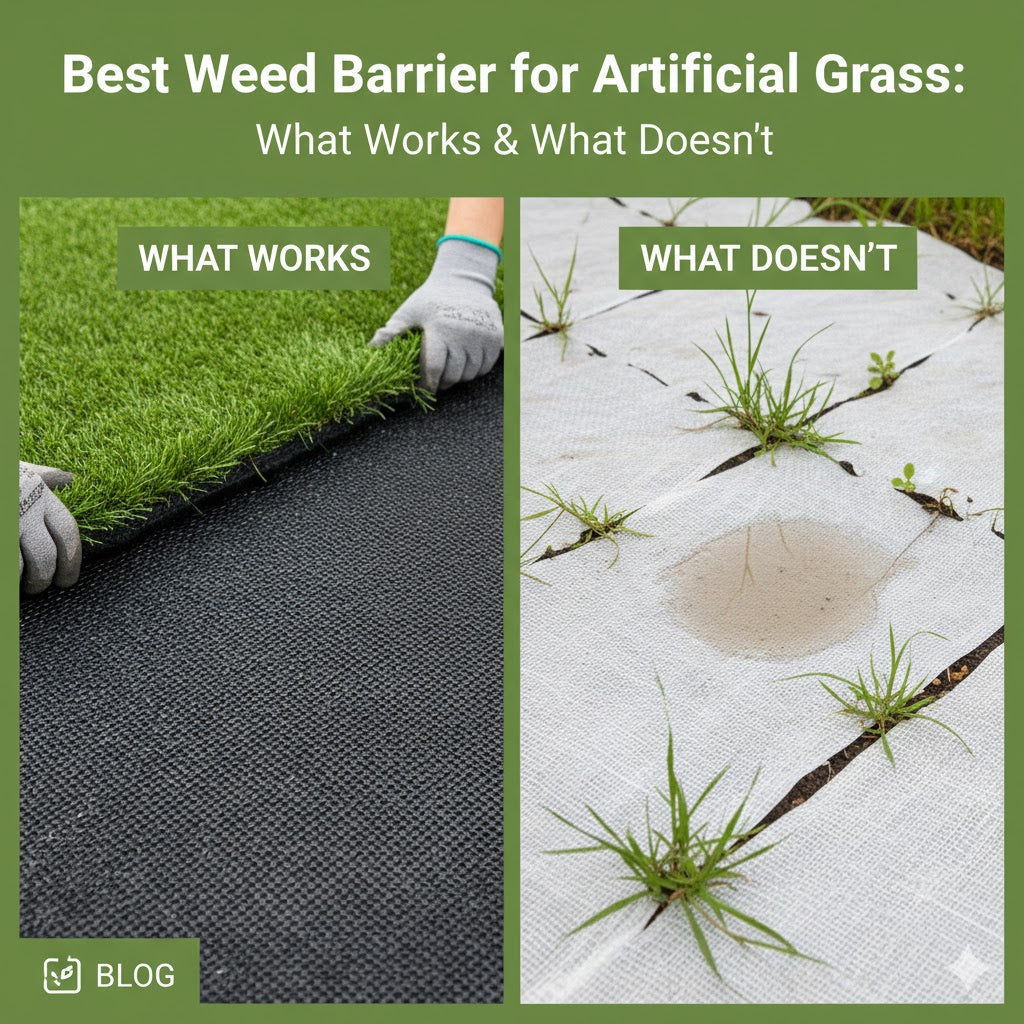When you buy artificial grass, the warranty is your safety net. It tells you what problems the company will fix and for how long.
A good warranty can save you money if something goes wrong like fading, tearing, or damage to the backing.
But not all warranties are the same. Some last only a year, while others can last up to ten years or more. Some cover just the turf itself, while others include the work done during installation.
That’s why it’s important to read the warranty carefully before you buy. If you’re buying from brands like LITA or others, always check the exact terms where you purchase it. Since they can change from store to store.
Two Kinds of Artificial Grass Warranties
When you buy artificial grass, you often get two main types of warranties. Each one protects you in a different way.
Product Warranty
This warranty comes from the company that makes the grass. It covers problems with the turf, such as fading color, weak backing, or loose fibers. It is meant to protect you if the product was made with a defect or wears out too early under normal use.
Installer Warranty
This warranty comes from the team or business that installs your grass. It covers things like poor seams, wrinkles, or drainage problems. These are issues that happen because of the way the grass was installed, not because of the product itself.
Both warranties matter. The product warranty protects the grass you buy. The installer warranty protects the work done in your yard. Having both gives you better peace of mind.

What’s Usually Covered
Most artificial grass warranties cover only certain kinds of problems. These are usually issues that happen because of how the turf was made, not because of how it was used.
A common warranty covers color fading. Over time, sunlight can make the grass lose its bright green look. Good turf should resist fading for several years, so many companies promise to replace or repair it if the color fades too fast.
Another thing often covered is backing strength. The backing is the bottom layer that holds the blades of grass. If it starts to peel, crack, or come apart too soon, that can be a sign of a manufacturing problem.
Some warranties also cover loose fibers or tuft bind. This means the blades of grass should stay firmly in place. If they come out easily, the turf might be faulty.
Most brands also include general manufacturing defects in their warranty. These are problems that were present when the product was made, not caused by you or by normal wear.
What’s Not Covered
Every warranty has limits. Artificial grass warranties are no different. There are some things they almost never cover.
Most companies do not cover normal wear and tear. Over time, all grass will flatten where people walk the most. This is considered normal use, not a defect.
Heat damage is also not covered. If your turf melts or shrinks because of hot window reflections, grills, or fire pits, the warranty won’t pay for repairs.
Many warranties leave out pet damage too. Things like chewing, digging, or stains from pets are seen as part of normal use.
Poor installation is another big exclusion. If the grass was not laid down correctly and problems appear later, that is the installer’s responsibility, not the product maker’s.
You’ll also find that chemicals, flooding, and accidents are not covered. If you use harsh cleaners or your area floods, the company will likely say it’s not their fault.
How Long Warranties Last
The length of an artificial grass warranty can be very different from one company to another.
Most residential lawns come with a warranty that lasts 8 to 15 years. Some companies even say “lifetime warranty,” but that doesn’t always mean forever. It usually means the product should last as long as it’s expected to under normal use.
For sports fields or commercial areas, the warranty is often shorter. These surfaces get more traffic, so the coverage might only last 5 to 8 years.
Some warranties use a pro-rated schedule. This means you get full coverage at first, but less as the turf gets older. For example, you might get 100% replacement in the first few years, but only 30% after ten years.
It’s also important to know what the warranty pays for. Many times, the company only covers the turf material, not the labor or the cost to remove and reinstall it.
Before you buy, check how long the warranty lasts and what exactly it covers. A shorter warranty that truly protects you can be better than a long one with many limits.

Maintenance Rules
To keep your warranty valid, most companies expect you to take good care of your artificial grass. Proper maintenance helps your turf last longer and look better.
You should brush the grass regularly. This keeps the blades standing upright and prevents them from getting flat. Use a soft brush or broom, not a metal rake.
Keep the turf clean and free of debris. Remove leaves, sticks, and trash so they don’t build up or block drainage.
Check the infill level once in a while. Infill is the sand or rubber material that helps the blades stay upright. If it gets too low, refill it as needed.
If you have pets, rinse the turf with water to prevent odors or stains. Avoid strong cleaners or bleach because they can damage the turf and void your warranty.
Also, make sure your yard drains well. Standing water can weaken the backing and cause mold.
Registration and Transferability
Some companies ask you to register your product after buying it. This means filling out a short form online or sending your proof of purchase. Registration helps the company confirm when and where you bought your turf.
If you don’t register your turf, the warranty might still work, but it could take longer to prove your claim later. Keeping your receipt and any warranty papers in a safe place is always a good idea.
Another thing to check is whether your warranty can be transferred to a new owner. Some companies let the next homeowner use the remaining warranty years. Others end the warranty as soon as the house is sold.
How to File a Claim
If something goes wrong with your artificial grass, don’t panic. You can file a warranty claim to ask for help or a replacement.
First, find your proof of purchase. This could be your receipt, invoice, or online order confirmation. You will also need any warranty papers or the website page that shows your warranty details.
Next, take clear photos of the problem. Try to show what’s wrong, such as fading, loose seams, or damage to the backing. Good pictures make your claim stronger.
Then, contact the company or the store where you bought the turf. Tell them what happened and include your photos and purchase information. Some companies have online claim forms, while others ask you to email customer service.
Be patient after you send your claim. The company may want to inspect the turf or ask for more details. If your claim is approved, they might send you new turf, repair the damaged area, or give you a credit toward replacement.
Red Flags
Not all warranties are fair or easy to use. Some may look good at first but have hidden limits. Knowing the warning signs can help you avoid problems later.
Be careful if the warranty doesn’t clearly explain what it covers. Words like “limited coverage” or “excessive fading” can mean almost anything. Always look for specific details.
Watch out for big promises with small print. A “lifetime warranty” might sound great, but it often comes with many rules and exclusions.
If the company says you must use their installers or products to keep your warranty, read that part closely. Sometimes this rule can make it harder to get help if you use another service.
Avoid warranties that drop coverage too quickly. Some pro-rated warranties give full coverage for only a few years, then pay almost nothing later.
Lastly, if you can’t find a written warranty document, that’s a bad sign. Always ask for a copy before you buy, and keep it safe for future use.

Compare Before You Buy
Before you choose artificial grass, take a little time to compare warranties. It can save you trouble and money later.
Start by checking the length of the warranty. A long warranty sounds nice, but make sure it truly covers what matters, like fading or tearing. Sometimes a shorter, clearer warranty is better.
Look for what is included. Good warranties list things such as color fading, backing strength, and manufacturing defects. If these are missing, ask the seller before buying.
Next, find out what’s not included. See if it mentions pet damage, burns, or normal wear. Knowing this helps you avoid surprises later.
You should also ask if the warranty covers labor. Many companies pay only for the turf material and not for removal or reinstallation.
Finally, save your proof. Keep your receipt, warranty paper, and a screenshot of the product page. If you ever need to file a claim, these will make the process much easier.
Conclusion
A warranty is your safety net when buying artificial grass. It helps protect you if the product has defects or wears out too soon. But it only works if you understand what it covers and what it doesn’t.
Before you buy, take time to read the warranty details. Look for clear terms about fading, backing, and defects. Watch for exclusions like pet damage, heat melt, or poor installation.
Always keep your receipt, product page, and warranty papers in a safe place. These are proof if you ever need to file a claim.
Need More Details?
Contact LITA Grass for complete warranty terms and maintenance guidelines in one place.



Leave a comment
This site is protected by hCaptcha and the hCaptcha Privacy Policy and Terms of Service apply.